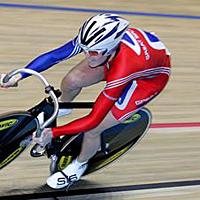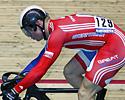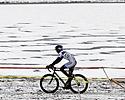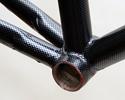*Special Edition* Cycling News for April 1, 2008Edited by the CN équipe Avril Imbécile New TTT format for 2009 Tour de France?By Kirk Mawlazes
The organizers of the Tour de France apparently not too busy fighting with the UCI to come up with new developments for upcoming editions of the Grande Boucle. A source inside the Amaury Sport Organisation (ASO) disclosed today to Cyclingnews that the race is considering a new twist on the team time trial format - something that was inspired by seeing the Little 500 race at Indiana University, made famous by the 1977 movie Breaking Away. "We were really interested in the 'bike exchange' that the teams are required to do," said the source. "We are contemplating a team time trial that is run more in a relay fashion, with four members of the team each riding a separate portion of the course - possibly even on the same bicycle." The talk of this new format is so new that most team directors were unaware of it when asked by Cyclingnews, other than to ask where they could rent a copy of the film for research. Slipstream-Chipotle-H30 director sportif Jonathan Vaughters was encouraged by the news, having served as the grand marshall of the race in 2004. "Yeah, I saw how they did the exchanges, so I think we would have an advantage in that regard," said Vaughters. Also working in Slipstream's favor is the fact that the team's operations director Chris Gutaowsky is a former winner of the race and elected to the Little 500 hall of fame. "I would love the chance to show these pros how to throw a bike exchange," said Gutowsky. "But it's too bad he wouldn't be riding on the fixed-gear, coaster brake machines we used!" "Mystic Manchester" leads to medal enquiryWorld records may be rejected if scientific evidence is foundBy Cheyenne Spokes
Following the lighting-quick times recorded at the world track championships in Manchester last week, scientists are looking into claims that a phenomena known as ley lines could have played a part in both those high speeds and the fantastic performance of the British team. Experts are looking into potential interaction between the mystical ley line and the stripes on the British team's skinsuits as a speed enhancer. Manchester just happens to lie in direct alignment with two important archaeological and spiritual sites which are located along a hypothetical ley line: Stonehenge and Rosslyn Chapel in Scotland. Some New Age theories propose that these lines resonate psychic or mystical energy, generating powerful electrical or magnetic forces. "Skeptics try to play this down because they cannot explain it with science," said longtime ley line expert Martyn Erlin to Cyclingnews on Monday. "They need to see to believe, they need to be able to measure and to quantify for something to exist. However there's a huge amount of examples from the recent and distant history of this country to show that something inexplicable, unquantifiable yet wonderful is going on." Manchester has long been regarded as a fast track but the number of world records, track standards and personal bests broken during the recent championships led experts such as Mr M. Erlin to ponder if something more significant was taking place. Erlin theorized that the triple stripes which adorn the British team's skinsuits came into harmony with the ley lines when the riders got into their aero tucks, and it's possible that the harmonic consonance between the parallel lines created a vacuum in front of the riders, creating less wind resistance and enhancing their speed.
"It’s early days yet but my belief is that the recent resurfacing in the velodrome is one of the reasons why we are now seeing a change to the energy patterns," he said, a couple of hours after British Cycling officials escorted him off the premises and promised legal action. "We made some drillings prior to being interrupted and it seems that a very special type of pine was used for the new track surface. This is more porous to the energies than the previous covering." When questioned about the British men's pursuit team, which wore the white UCI leader's kit rather than the standard British team strip, Erlin revealed that the riders had worn special undershirts with the triple-stripe pattern, indicating that the team was fully aware of the interaction with the mythical ley lines. In the past hour Cyclingnews has learned that this mystical home advantage is being investigated by both the UCI and the IOC, and that the outcome could have severe implications for the nine gold medals won. An official from the latter organisation, who spoke only on the condition of anonymity, said that the results of the races could be in doubt if it was shown that such forces were at work. "In a time when everything is being done to limit banned performance enhancers, it would be hypocritical of us to accept anything that may have benefited from a boost. No matter what that boost is. We'll be studying this very carefully and if it can be shown that anything peculiar was at work in Manchester, gold medals and world records may well be scrapped. Down with this sort of thing." New 'cross world cup event on seventh continentBy Kirk Mawlazes, Antarctic Editor
In an effort to boost tourism to the world's seventh continent, the Antarctic Heritage Trust and several Antarctic tour companies have come together to announce a new cyclo-cross World Cup event for the 2008-09 season, named the 'Antarcticross Cup.' The two races will be held at the British outpost of Port Lockroy on Goudier Island in the Antarctic peninsula and at Patriot Hills at the foot of the Ellsworth Mountains. It will be the first cycling event of its kind on the entire continent. The event is fully supported by the UCI, which has been pushing for globalisation of the sport in recent years. The governing body is hoping to gain a foothold in the far southern hemisphere by promoting one of just two sporting events in Antarctica, the other being the annual marathon, know as the Ice Marathon. In fact, the two races will be held on similar dates to facilitate spectators interested in watching both. "We planned our dates of 13-14 December because the marathon is on 12 December, which makes for an entire weekend of sport on the continent," said race director Cody Maverick. "This is going to be a very exciting race and should add even more depth to the world cup series." While some might assume the extreme nature of the Antarctic environment would prove to be too harsh, with some of the most extreme cold temperatures found on Earth, Maverick said that the December date in the heart of the Austral summer allow for bearable temperatures. "Summer temperatures are routinely around -6 C (20 F), which is not much harsher than that of northern Europe. The only major temperature difference is the wind, which could make it much colder. Also there are a lot of penguins around the area - but that is what will make it interesting!" An Ilyushin-76 plane will be used to transport the entirety of race personnel, riders and equipment to each site. People interested in spectating will be able to arrange for transport with one of the many companies that provide sea/land tours to the Austral region. Riders will be encouraged to make appropriate adjustments to their equipment, such as special treads for the tyres. UCI imposes limit on team namesBy Raol Awileus The UCI announced this week that it would impose an immediate restriction on the length of team names in order to integrate its whereabouts system with other worldwide databases. In the midst of creating a global integrated website to pull together the massive amount of data created by its biological passport program, the sport's governing body ran into a major snag - long team names would not fit in the database. "Unfortunately, every team seems to have its own system for tracking rider whereabouts," said a UCI spokesman. "It all comes down to the weakest link, and that was one system, which will remain nameless, which had a constraint on the team name field." The field length was set to 32 characters, far too small to allow the entire team name of squads such as the Serramenti PVC Diquigiovanni-Androni Giocattoli team, which clocks in at 47 characters, but it most certainly would not accomodate the An Post-M. Donnelly-Grant Thornton-Sean Kelly Team and its unwieldy 50 letters. "The UCI understands that title sponsors want to be represented in all the results and press that the team earns, but it's getting out of hand! First we had US Postal presented by Berry Floor and now every team is presented or powered by a minor sponsor. 50 years ago, a team could fit its name on the front of one crudely stitched woolen jersey. We're recommending that teams pursue title sponsors with shorter names if they want to incorporate them all into its identity." "Astana, Liquigas, Quick Step - they're all great teams and have names which are succinct and memorable. Do teams really think that including five different sponsors in the name is going to increase the impact for each company? "We also suggest that the teams leave off 'pro cycling team' or 'cycling team' from the name for brevity's sake. If you're in a bike race, we all know you're a bike racing team, isn't it a bit redundant?" None of the ProTour teams will be affected by the change, although the Cofidis, le Credit Par Telephone squad is right on the limit with 32 letters. "We considered restricting the amount of capital letters in the name, too," the spokesman continued, "but we couldn't come up with a technical reason why it should be disallowed. However, we are looking into the concept for future seasons for purely aesthetic reasons." Judge Judith Sheindlin to decide Landis' fateBy Kirk Mawlazes, North American Editor The Court of Arbitration for Sport (CAS) announced today that a decision in the most recent Floyd Landis vs. USADA arbitration hearing would be impossible to render, due to a lack of openness in the proceedings. The CAS panel said that since no decision will be reached by them in their closed deliberations, they are handing the final decision off to a third-party single adjudicator with the ability and infrastructure to make it as public as possible, to be agreed upon by both parties. And after discussing with each sides' counsel, the judge named is the honorable Judith Sheindlin. "Both sides are interested in as much public transparency in this case as possible," said court spokesperson Petri Hawkins-Byrd. "We will do our best to make sure a fair decision is rendered and that the public gets to see every aspect of the hearing." Sheindlin, a former family court judge, has served as an arbitrator for the past 12 years on her syndicated television show Judge Judy. This will be the venue for the final decision and is expected to air as a special month-long series on her program. "Both the USADA and Landis camps have acted like children at times in their previous hearing," Sheindlin said. "So I think it is fitting that a family court judge finish this case." Tech test: Carbon fiber performance for everyone?
Carbon-wrapped aluminum seems to be the next frontier of materials technology and at least one company thinks the benefits may be easier to come by than previously thought. Cyclingnews technical editor James Huang pulls up his sleeves to see if there's any truth to the company hype. We're reasonably firm believers in the advantages of carbon-wrapped aluminum parts over their non-wrapped counterparts. When properly executed (purely cosmetic samples are obviously excluded from this group), the resultant components do seem to be nearly as stiff as full carbon parts but the aluminum cores retain the ductile failure mechanisms associated with most metals. However, when Colorado retailer Chris Jacobsen first informed us of his intriguing Jacobsen Carbon Wrap-It system, we were rightfully skeptical. Jacobsen proposed that consumers could wrap their own frames and parts and achieve nearly the same results as far more expensive factory jobs. As such, his rather inexpensive do-it-yourself kit could transform relatively mundane aluminum frames, forks, stems, bars, or nearly any other bit into a stronger and stiffer equivalent, all at a surprisingly reasonable cost as well. The goodsThe kit is rather straightforward, consisting of a roll of pre-preg carbon fiber sheet complete with an easy-to-apply adhesive backing. Frame kits include enough to treat most typical aluminum frames, large diameter ones included, while componentry kits contain enough material to treat about four or five small parts, depending on what they are. Items to be wrapped must first be carefully cleaned using the included non-toxic solvent. After approximating the amount and shape of material required, users then simply cut the pre-preg carbon fiber sheet to size with standard household shears then wrap the material tightly around the substrate. After a 24-hour waiting period to cure the adhesive, the treated bits are ready to go. An optional kit adds a heat-activated compressive layer to the assembly to reduce cure time while also improving bond strength and reducing voids. We decided to go straight for the gusto and wrapped an entire frame, in this case an old bonded aluminum job that had been laying fallow in storage for several years after being unceremoniously retired. Total time required was roughly an hour, although more complicated frames could easily take twice that time. The installation process was a bit messy so we'd recommend wearing gloves and laying down a tarp to protect flooring but otherwise was pleasantly straightforward. To read the full special product review, click here. (All rights reserved/Copyright Future Publishing Limited 2008) |

|
January 2009 |
Recently on Cyclingnews.com |





